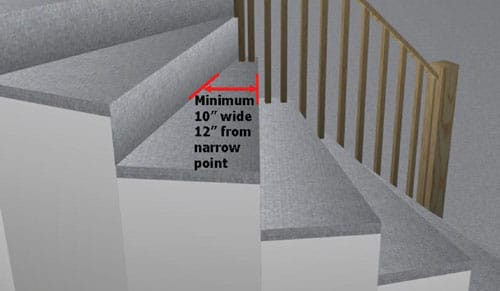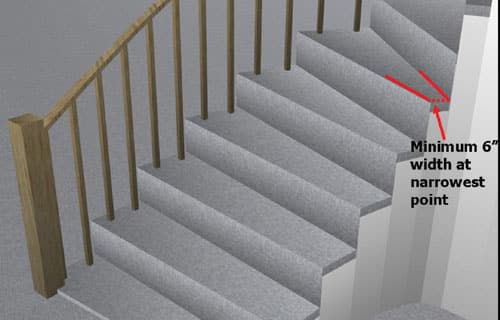Code Corner: More About 2006 IRC Stairway Requirements
This installment of Code Corner is part two in a series looking at stairway requirements of the 2006 International Residential Code. This installment will focus on the different requirements of winder treads and spiral staircases. Stairways are considered a means of egress in the home, so proper stairway dimensions are essential to occupant safety.
Winder treads are tapered, causing the staircase to curve or change direction abruptly. A staircase may consist of both typical stair treads and winder stair treads. As a rule, a spiral staircase has all its treads attached to a center pole.
Winder staircases
While both the winder-type stair and the spiral stair have a curved direction of travel, the requirement for each is substantially different.
Winder stair treads are treated similar to the typical stair tread in terms of rise and run: 7-3/4 inches is the maximum tread rise. However, the nature of the winder staircase says that its shape will be narrower on the inside edge, leading to a pie-shaped tread. This is where additional requirements come into play, separating the winder tread from a typical straight stair tread.

Minimum tread depth requirements for a winder stair tread. Guardrail has been omitted for clarity.
First and foremost, a winder tread cannot come to a point narrower than 6 inches at the inside edge. This is different from the common practice in the past of forming a 90-degree turn in a staircase by use of two 45-degree angle treads that came to a point on the inside corner. In addition to the
6-inch inside edge requirement, there is a requirement for a minimum 10-inch-tread depth 12 inches from the inside edge. Since the most common path of travel up and down a staircase is confined to the inside half of the tread, the code requires that same minimum 10-inch tread depth one foot from the inside since most people are not walking on the inside 12 inches of the stairway. This is a compromise between safety and functionality in a curved staircase.

Minimum tread depth for a winder stair at the narrowest point, 6 inches. Guard has been
eliminated for clarity.
Spiral staircases
Spiral staircases fall under totally different code requirements. The minimum width of a spiral staircase is 26 inches, 10 inches less than a typical or winder staircase. Spiral stairs have no minimum tread depth at the narrow end and a minimum of 7-1/2 inches of tread depth at a point 12 inches from the inside edge. The maximum rise is 9-1/2 inches, much greater than the typical staircase. All treads within a spiral stair must be identical.
Even headroom requirements are less restrictive for spiral staircases. The minimum head room requirement is reduced to 6 feet 6 inches rather than 6 feet 8 inches. Spiral staircases can offer obvious advantages in terms of fitting a stairway into a tight space. Although a spiral staircase is more awkward to use, there are no restrictions placed on its location and use in the code.
Robert Moss, Wisdom & Assoc., Kenai, Alaska, is an ASHI Certified Member, who joined ASHI in 2002. Visit his company Web site at www.wisdomandassociates.com.
To Read the Full Article
ASHI offers its members unparalleled resources to advance their careers. ASHI offers training for inspectors at all levels of knowledge and experience, including resources about all major home systems. Members benefit from a vast network of experienced professionals, providing a community for mentorship and knowledge sharing..
In this Issue

FIND A HOME
INSPECTOR
Professional Networking
Grow your professional network, find a mentor, network with the best, and best part of the community that’s making home inspection better every day.
